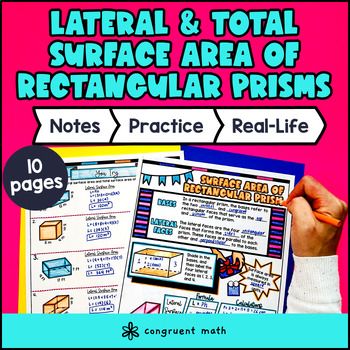Want more ideas and freebies?
Get my free resource library with digital & print activities—plus tips over email.
Join for Free Resources →
$4.25
Ever wondered how to teach calculating lateral & total surface area of rectangular prisms in an engaging way to your 7th-grade students?
In this lesson plan, students will learn about finding the surface area of rectangular prisms and their real-life applications. Through artistic and interactive guided notes, check for understanding activities, a doodle and color by number activity, and a maze worksheet, students will gain a comprehensive understanding of lateral and total surface area.
The lesson culminates with a real-life application where students will read and write about the real-life uses of surface area calculations. This application helps students understand the relevance and importance of the concept in practical situations.

$4.25
After this lesson, students will be able to:
Before this lesson, students should be familiar with:
As a hook, ask students why understanding the lateral and total surface area of rectangular prisms is important in real life. Refer to the last page of the guided notes as well as the FAQs below for ideas.
Use the first page of the guided notes to introduce the concept of bases vs. lateral faces of a prism. Then, explain the difference between lateral surface area and total surface area. Students will fill in the formulas as you teach, and you can model the example on the bottom of the first page.
Based on student responses, reteach any concepts that students need extra help with. If your class has a wide range of proficiency levels, you can pull out students for reteaching, and have more advanced students begin work on the practice exercises.
Have students practice calculating the lateral and total surface area of rectangular prisms using the practice worksheet (page 2 of guided notes) included in the resource.
Walk around the classroom to answer any student questions and provide assistance as needed.
For students who finish the practice worksheet early, they can practice, in groups or independently, by completing the maze activity (page 3 of guided notes) provided in the resource. Then, have students complete the color by number activity (page 4 of the guided notes) to further reinforce their understanding.
You can also assign the maze or color by number activity as homework for students to practice.
Use the last page of the guided notes, real life applications, to bring the class back together, and introduce the concept of real-life applications of calculating lateral and total surface area of rectangular prisms. Explain that these calculations are used in various real-world scenarios to solve practical problems involving objects with rectangular shapes.
For example, explain how architects and builders use the concept of surface area to determine the amount of paint or wallpaper needed to cover the walls of a room or the exterior of a building. By calculating the total surface area of the walls, they can estimate the quantity of materials required, helping them plan and budget for the project.
Students will read a passage (page 5 of guided notes) about another application of surface area - packaging design. Companies that manufacture products need to design packaging that is efficient and cost-effective. By calculating the lateral surface area of a rectangular prism-shaped box, they can determine the amount of cardboard or other material needed to create the packaging. This information helps them optimize the design and keep the production costs down.
You can also discuss how understanding surface area is important in landscaping and gardening. For instance, if a homeowner wants to install artificial turf in their backyard, they need to calculate the total surface area of the area to determine how much turf they will need to purchase. Similarly, when planning a garden, knowledge of surface area helps in determining the amount of soil, mulch, or fertilizer needed.
Refer to the FAQ section of the resource for more ideas on how to teach the real-life applications of surface area calculations.
A fun, no-prep way to practice calculating lateral and total surface area of rectangular prisms is with Doodle Math activities — they’re a fresh take on color by number or color by code. They include multiple levels of practice, perfect for a review day or sub plan.
Here are some activities to try:
A fun, no-prep way to practice cross sections of 3D figures is Doodle Math — they’re a fresh take on color by number or color by code. It includes multiple levels of practice, perfect for a review day or sub plan.
Here are some activities to try:
The lateral surface area of a rectangular prism is the sum of the areas of all the lateral (non-base) faces of the prism.
To calculate the lateral surface area of a rectangular prism, multiply the perimeter of the base by the height of the prism.
The total surface area of a rectangular prism is the sum of the areas of all the faces of the prism, including the bases and the lateral faces.
To calculate the total surface area of a rectangular prism, find the area of each face of the prism and then add them together.
Calculating the surface area of rectangular prisms is useful in various real-life situations, such as:
Some engaging teaching strategies for teaching lateral and total surface area of rectangular prisms include:
Some common mistakes that students make when calculating the surface area of rectangular prisms include:
To differentiate instruction for students with different levels of understanding, you can:
Get my free resource library with digital & print activities—plus tips over email.
Join for Free Resources →